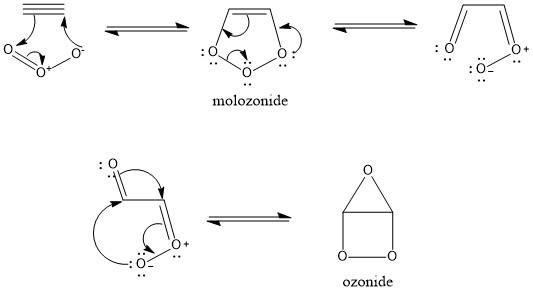
Acetylene on ozonolysis gives glyoxal.
A.True
B.False
Answer
493.2k+ views
1 likes
Hint:Alkynes undergo ozonolysis to give an acid anhydride or a diketone as the final product. The fragmentation is not complete in this reaction (alkenes undergo complete fragmentation). Acetylene contains a triple bond. Draw the structure of the ozonide formed on ozonolysis. The multiple carbon-carbon bond is replaced by a carbonyl group. Glyoxal has the chemical formula
Complete step by step answer:
Ozonolysis is a method of oxidative cleavage of alkenes and alkynes using ozone that means cleavage of bonds, occurring with oxidation.
Ozone is an allotrope of oxygen and is reactive. It gets added to an alkene or alkyne to form ozonide.
The ozonide is then cleaved by
The reaction is as follows:

Reaction mechanism:

The first step in the mechanism of ozonolysis is the initial electrophilic addition of ozone to the carbon-carbon triple bond. This forms the molozonide intermediate.
It is an unstable intermediate and continues further with the reaction. It undergoes fragmentation to form a molecule with a carbonyl group and a carbonyl oxide group.
The carbonyl and the carbonyl oxide rearrange itself and form a stable ozonide intermediate. This undergoes a reductive workup using zinc in water. In this step, we add a reducing agent that decomposes the intermediate formed (ozonide) into (glyoxal in this case).
The third oxygen atom of the ozone is attached to the reducing agent which then turns into ZnO during the reductive workup.
Therefore, acetylene undergoes ozonolysis to form glyoxal.
Hence the correct answer is (A) True.
Note: If the reaction happens in the presence of water, the acid anhydride undergoes hydrolyzation to give two carboxylic acids.
Ozonolysis can also be used to determine the position of the triple bond in an unknown alkyne.
The reductive workup can also be carried out using dimethyl sulfoxide (DMSO).
Complete step by step answer:
Ozonolysis is a method of oxidative cleavage of alkenes and alkynes using ozone that means cleavage of bonds, occurring with oxidation.
Ozone is an allotrope of oxygen and is reactive. It gets added to an alkene or alkyne to form ozonide.
The ozonide is then cleaved by
The reaction is as follows:

Reaction mechanism:

The first step in the mechanism of ozonolysis is the initial electrophilic addition of ozone to the carbon-carbon triple bond. This forms the molozonide intermediate.
It is an unstable intermediate and continues further with the reaction. It undergoes fragmentation to form a molecule with a carbonyl group and a carbonyl oxide group.
The carbonyl and the carbonyl oxide rearrange itself and form a stable ozonide intermediate. This undergoes a reductive workup using zinc in water. In this step, we add a reducing agent that decomposes the intermediate formed (ozonide) into (glyoxal in this case).
The third oxygen atom of the ozone is attached to the reducing agent which then turns into ZnO during the reductive workup.
Therefore, acetylene undergoes ozonolysis to form glyoxal.
Hence the correct answer is (A) True.
Note: If the reaction happens in the presence of water, the acid anhydride undergoes hydrolyzation to give two carboxylic acids.
Ozonolysis can also be used to determine the position of the triple bond in an unknown alkyne.
The reductive workup can also be carried out using dimethyl sulfoxide (DMSO).
Recently Updated Pages
Master Class 4 Maths: Engaging Questions & Answers for Success

Master Class 4 English: Engaging Questions & Answers for Success

Master Class 4 Science: Engaging Questions & Answers for Success

Class 4 Question and Answer - Your Ultimate Solutions Guide

Master Class 11 Economics: Engaging Questions & Answers for Success

Master Class 11 Business Studies: Engaging Questions & Answers for Success

Trending doubts
Give 10 examples of unisexual and bisexual flowers

Draw a labelled sketch of the human eye class 12 physics CBSE

a Tabulate the differences in the characteristics of class 12 chemistry CBSE

Differentiate between homogeneous and heterogeneous class 12 chemistry CBSE

Why is the cell called the structural and functional class 12 biology CBSE

Differentiate between insitu conservation and exsitu class 12 biology CBSE




